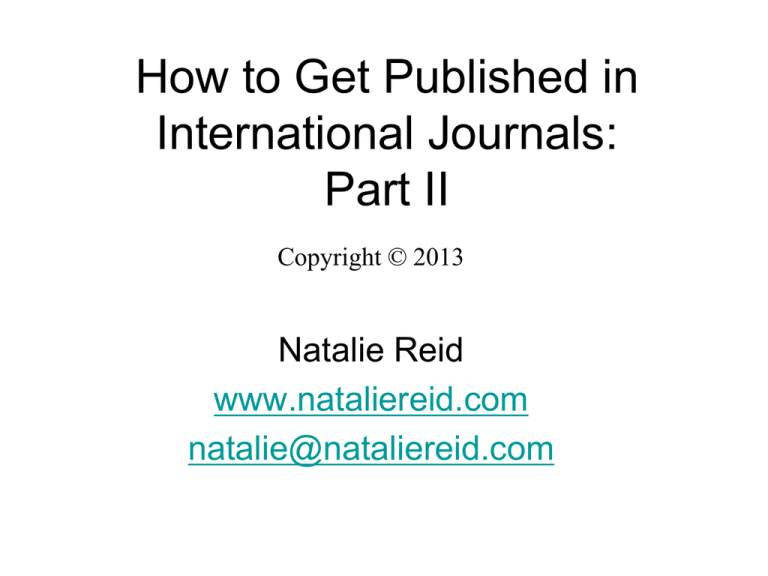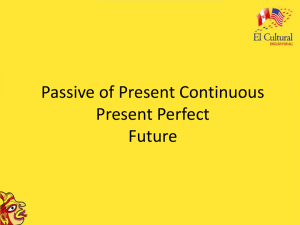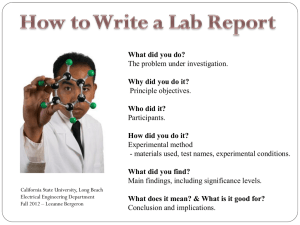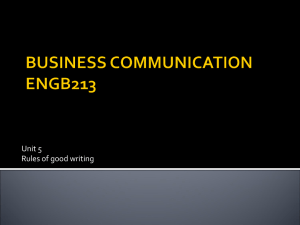Getting Published in International Journals
advertisement

How to Get Published in International Journals: Part II Copyright © 2013 Natalie Reid www.nataliereid.com natalie@nataliereid.com Source Material • Getting Published in International Journals: Writing Strategies for European Social Scientists by Natalie Reid, (NOVA, 2010; Oslo) www.nova.no/reid www.amazon.com www.nataliereid.com Strategy 2: Editing for Clarity • Avoiding Ambiguity: Using pronouns correctly • Writing in the Active (not passive) Voice • Placing Words Where They Belong: Using modifiers correctly • Using Parallel Structure • Punctuating for Clarity in UK or US (or other) English Active v. Passive Voice I like ice cream. (S + V + O) [“Active” because the S is doing the action] Ice cream is liked by me. O masquerading as subject + passive V [is liked] + S forced into the OP position [as the object of the preposition “by”] [“Passive” because the S is passive, i.e., is having something done to it] Active v. Passive Active: The participants asked excellent questions. Passive: Excellent questions were asked by the participants. Make the first sentence active. Then fix the pronoun problem in the second sentence. “In the following four sections an [X] example of a [Y] case study is presented. It shows how to form the [Z].” Another Strategy for Eliminating the Passive Voice The findings are presented in Table 4. The findings appear in Table 4. The idea that the French social model may no longer be functioning or may not be a model for other European countries is just starting to be discussed in France. The idea that the French social model may no longer be functioning or may not be a model for other European countries is an idea just entering French discourse. Issue of Acceptability of Passive Voice: “soft” vs “hard” tone • The relevance of an early diagnosis to the further course of the disease should have been outlined more clearly. [Some consider this tone softer.] • [He] should have more clearly outlined the relevance of an early diagnosis to the further course of the disease. [Some consider this tone too hard or harsh.] [to be continued….] Resolution: Other Active Voice Options The relevance of an early diagnosis to the further course of the disease needed clearer outlining. or A clearer outline would have better shown the relevance of an early diagnosis to the further course of the disease. Modifier Problems • The doctor told her patient frequently to exercise. Modifier Problems • Found: a purple man’s coat Dangling Modifier Problems • To validate the results, a second experiment was conducted. [A “second experiment” did not validate the results.] • Based on the results, we conclude that X factors do not cause Y conditions. [“We” are not “based on” the results.] Dangling Modifiers Wrong: Based on our review of the findings, we agree that the researcher should reconsider his conclusions. Right: Based on our review of the findings, our position/our decision is that the researcher should.... After reviewing the findings, we agree that the researcher should.... Given the findings, we agree that the researcher should.... Using Parallel Structure • Parallel information must appear in parallel style. • A sentence starting with “also” is usually a firstdraft sentence giving information that belonged in the sentence that preceded it. • Sentences using co-relative conjunctions (eitheror, neither-nor, both-and, not only-but also) must present material in parallel style. Parallel Structure Poor: The organization of the group provided an effective framework for the sharing of knowledge and skills development. Better: The organization of the group provided an effective framework for skills development and the sharing of knowledge. Parallelism (cont.) As explanatory variables in the models we include i) a set of socio-economic variables such as educational level, marital status, dependent children and age; ii) a set of job characteristics such as part-time work, union membership, labour market sector and industry sector; and iii) to control for the influence of the economic activity we include variables for unemployment regions and yearly indicators. Punctuation • Punctuation is a code of meaning signifiers critical to clarity in English. • The absence or presence of a comma in a particular place can not only change but actually reverse the meaning of a sentence. • UK and U.S. English use very different punctuation. • Apply every rule in any style manual that your journal of choice wants you to use. • If the journal specifies none, use one of the best. Strategy 3: Organizing and Arguing in Aristotelian logic • • • • Arguing according to the Greeks Ethos, pathos, and logos Five-paragraph essay model John Swales’ CARS model: – Establish the territory – Establish the niche – Occupy the niche (i.e., purpose statement) Framing! In English you must frame every paragraph, every section, and every paper. A useful resource is the following: www.academicphrasebank.manchester.ac.uk This site offers sample framing sentences for every part of the paper and for almost any kind of paper. What Goes Where in a Paper • Introduction (depending on journal) – Necessary background / territory & niche – Purpose statement – Brief description of data set – Scope – (in certain fields) Results & conclusions What Goes Where in a Paper • Body (everything between the introduction and the conclusions) necessary theory or background or literature review methodology data results (plus robustness checks, etc.) What Goes Where in a Paper • Conclusion – Nothing new goes in a conclusion! It must derive solely and logically from the information and organization contained in the Body. – If the journal has a Discussion section.... What Goes Where in a Paper • Discussion / Recommendations for Future Research, etc. – These sections must naturally come out of the Conclusions; that is, they must remain within the framework of all previous discussions (e.g., our study of X was limited to Country Z; future research should include other countries / additional environmental factors, such as....) The Abstract • Should be presented first but written last • Should never exceed journal’s word limit. [Usually includes territory (if nec.), niche, purpose statement, results, conclusions, future research (if nec.)] • Should omit details • Must follow style of most common abstract pattern in journal Strategy 4: Journal Analysis • NEXT WEEK’S LECTURE: • Elimination analysis: how to eliminate all journals that are inappropriate to your paper for one reason or another • Submission analysis: linguistic and organizational analysis of your journal of choice Strategy 5: Revision & (Re)Submission “Over 200 years ago Benjamin Franklin wrote: ‘Either write something worth reading or do something worth writing.’ Scholars, engineers, and researchers need to do both. The quality of the writing must be as good as its contents, and you must be as good a writer as you are a thinker, theorist, or researcher. If the writing isn’t good, your publication chances are very poor.” [Adapted from Getting Published in International Journals, p. 249.] Preliminary Revision Checklist • Is my language correct? – Did I use “claim” when I meant “state”? – Do I mean “comprise” or “constitute”? – Have I eliminated “in fact,” “so-called,” “the fact that,” and other words that constitute poor style? • Is everything in the appropriate section? • Does my argument support my conclusion? • Am I bored or confused reading a certain passage (because if I am, the reader certainly will be)? Preliminary Checklist, cont. • Does my argument proceed logically? Is it airtight? • Have I named and countered all possible objections? • Have I considered and minimized all possible disadvantages? • Have I anticipated and answered all my reader’s likely questions? Preliminary Checklist, cont. • Have I defined all my terms—and in the right place (i.e., at first mention)? • Have I used any language with which my reader may not be familiar? • Have I proofread every word and punctuation mark? • Am I consistent in vocabulary, spelling, punctuation, and grammar for UK or U.S. (or other) English? • Am I using the right “confidence tone”? Most Important • Does everything (e.g., # of tables, length of sections) match the style of the journal? • Have I followed the journal’s style/author guidelines (e.g., APA Style Manual, Chicago Style Manual) to the letter? [This question includes consistency issues such as “percent” v. “%”] Most Important, cont. • Has a properly skilled native speaker of English read and edited the final draft? [Not every native English-speaking scholar is a good academic stylist, nor is a neighbor’s American, British, or Canadian spouse with no training in editing or academic writing a wise choice.] Resubmission Letters • Never assume that the editor remembers the content of your paper or anything that he or she wrote to you. • Never make the editor have to go back and forth between two documents. • Therefore, always cut-and-paste the reviewers’ comments, with your revisions and comments following in a different font or format. Resubmission letters, cont. Use language such as – I applied this helpful suggestion to.... – As referee 2 has suggested, I have changed.... – This revision makes much more clear how we draw our conclusions. – Thanks to this comment, the revised article now more clearly focuses on.... – Following reviewer 1’s suggestion, we have considerably reduced the extended example. We now link the case directly to both the theoretical framework and the practical consequences of X for [specific group]. To Recap: Some Overall Guidelines • • • • • • • • • Be as concise as possible without sacrificing meaning. Keep your sentences and paragraphs reasonably short. Define all your terms the first time you mention them. Always be clear—never allow your reader to become confused (not even for one sentence). Write in the active voice. Frame (contextualize) everything. Frame your paper as important to the field. Always let the reader know what you are doing—and why. Create as airtight a proof as possible. Always write for a specific journal. Revise and revise. Then have a skilled native speaker of English edit the final draft for grammar and argumentation.






